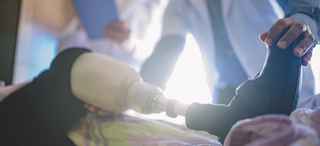What to Expect
Receiving and adjusting to wearing a prosthetic limb takes time and patience. At UT Southwestern, patients work with a variety of skilled clinicians who provide expert care at every step along this journey.
If a patient receives a prosthesis following an amputation, the process can begin four to six weeks after amputation surgery if the wound is fully healed and the swelling has reduced.
Everyone’s experience is unique, but in general, the process involves:
Initial evaluation: We will perform a comprehensive evaluation to assess everyday function, including:
- Wounds
- Pain management needs
- Mental health
- Other factors that are unique to the patient
Our clinicians will also answer any questions and address the concerns patients might have about living with a prosthetic limb.
Selecting the prosthesis: From there, we will develop a tailored treatment plan based on the patient’s needs. Our physicians will collaborate with device specialists to identify a prosthesis that fits the patient’s body best and suits the activity levels of their work, hobbies, and recreational interests, as well as overall health goals.
Finding the right device might include making a cast of the patient’s residual limb and using the cast to create a temporary socket to connect the residual limb to the prosthetic limb.
Preparation: Before patients receive a prosthesis, we make sure they understand what to expect in terms of pain management, recovery, and function.
We also may recommend:
- Skin desensitization techniques to make the skin that will be in contact with the prosthesis less sensitive
- Physical therapy to strengthen muscles, improve general energy levels, and prepare the patient for the demands of an artificial limb
- Consultation with our rehabilitation psychologists to help the patient prepare mentally and emotionally for changes in lifestyle
Rehabilitation: After patients receive a prosthesis, our team works closely with them to help ease pain and improve function.
Patients will learn hygienic methods to care for the prosthesis and protect the skin on the residual limb from irritation and damage.
Physical and occupational therapy will help patients:
- Transition to wearing a prosthetic with confidence and comfort
- Learn how to use the prosthesis for self-care, work, and leisure
- Maintain and increase strength, flexibility, coordination, and endurance
- Practice independent living skills
- Avoid complications
During the first year after an amputation and placement of a prosthetic limb, a patient’s body will undergo many changes. Frequent follow-up visits are normal to assess the replacement limb for fit and function, evaluate any residual limb pain and phantom pain, and continuously review pain management plans.




